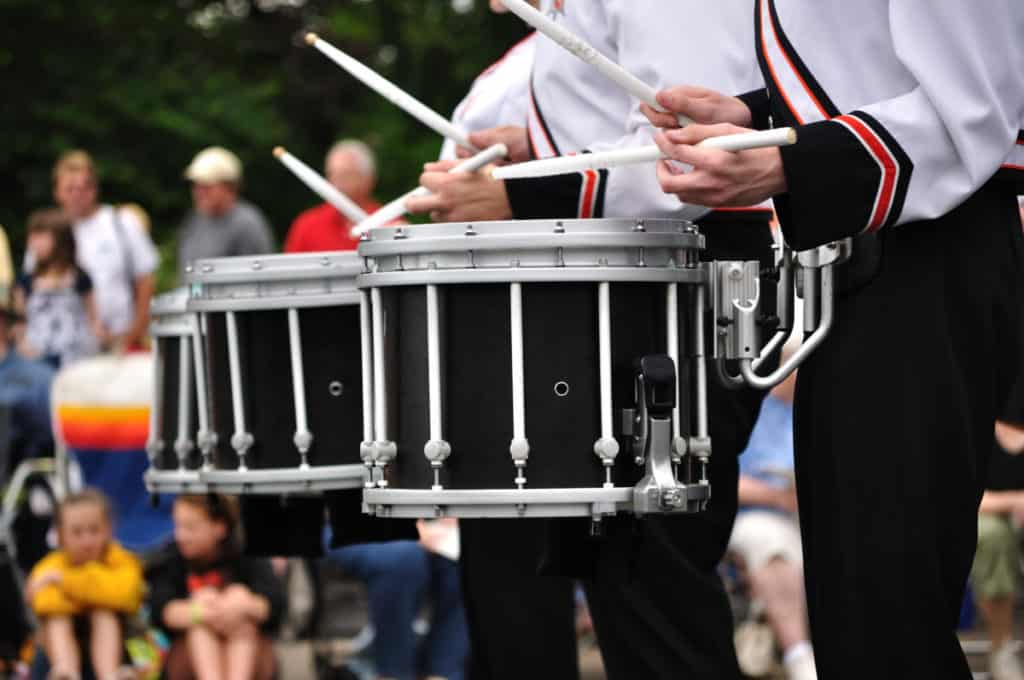This post contains affiliate links. We earn commissions if you purchase products from retailers after clicking on a link from our site. As an Amazon Associate, we earn from qualifying purchases.
Believe it or not, this is a harder question to answer than you might expect, because a lot of websites don’t provide all the weight details of their marching percussion. I was curious myself and so I decided to do some research.

By the way, looking for recording equipment and musical instruments? Check out Sweetwater.com for microphones, monitors, audio interface or any other recording gear that you could ever need. (Affiliate Link)
Marching Percussion weights vary mostly depending on the size of the drum and the related hardware, as well as the thickness of the wood.
- 14×12″ Marching Snare Drum Weight: 17lbs
- Tenor Quads Drum Weight: 22lbs
- 20×14″ Bass Drum Weight: 16.5 lbs
The above weights I just mentioned are examples of weights for drums in these categories, but the actual answer is more complicated.
The drummer has to wear hardware and equipment to even carry the drums. Often these carriers can weigh over 10lbs! To see a more comprehensive list of drum weights, see the table below.
Weights of Marching Band Drums
As I mentioned in the beginning of this post–this information was surprisingly difficult to find. I was able to find the most data on Dynasty’s product website–which this brand is known for having heavier drums than normal, but this would only impact the weight by a couple pounds for similar models–but I tried to crosscheck across several other products where I could find the weight.
The first complicating factor is what carrier you are using to carry your drum. It is possible to use straps instead of an aluminum or other metal harness. Straps weigh less than a pound, but metal-frame harnesses where you suspend drums and which are pretty much the only option for quads can weigh anywhere from 8-15lbs.
| Drum Type | Weight Range |
|---|---|
| Marching Bass Drum from 14″ diameter to 32″ diameter | 13-26lbs |
| Tenor Drum Quads (some cuts are much shallower) | 12-26lbs |
| Snare Drum (some snares are not as deep hence the weight difference) | 10-18lbs |
| Cymbals (ranges from 14-18″) | 2.5-5lbs |
| Bells (not as common to carry these anymore) | ~30lbs |
| Tenor Drum Quints | 16-28lbs |
| Tenor Drum Sextets | 18-31lbs |
| Xylophone | 20-25lbs |
What Is the Heaviest Instrument in Marching Band?
The weight varies depending on the instrument, naturally, but after some research, there are two instruments that are tied for weight: The Sextet Tenor Drums and the Bass drum are the heaviest instruments if you include the weight of a 10lb harness, weighing anywhere from 35 upwards to 42 lbs.
The weight goes up even more if you use any attachments such as cymbals or cowbells!
Without the harness, then the sousaphone can get up to that kind of weight, for example, the Jupiter 590 sousaphone weighs 31 lbs.
Make no mistake, you have to have some muscles to be percussionist in a marching band. One thing that’s easy to overlook is the strength to carry brass instruments. Although a french horn weighs much less than other instruments, you are holding that weight in front of you.
As a father of a small child, I know how tiring it can be to weigh something comparatively light in front of your body without a harness!
So, if you’re in marching band, chances are you’re buff.
Why do Marching Snares (and Other Marching Drums) Weigh So Much?
Marching Snares are different than a snare drum on say a drumkit or other types of drums in that marching snares are designed to be extremely solid. For good reason, these drums withstand lots of physical shock and are exposed to the elements, be it rain, extreme heat or cold, etc.
Perhaps the most shock comes from the fact that the snare drum is mounted to the player via a carrier, and that player is marching–that’s a lot of stress. Marching snares and other drums have reinforcing hardware that ensures the drum stays in the same shape, this significantly adds to the weight.
Perhaps most importantly, is that marching snare drums and other types of marching drums are deeper than drums you’d find on a drumkit.
Deeper drums = more wood = more hardware = more weight.
Why are deeper drums used? Simple, the answer is projection.
Believe it or not, it’s actually controversial whether or not deeper drums are louder, but an undisputed fact is that deeper drums of the same thickness and tuning are lower pitched than shallower drums of the same thickness and tuning. Lower sound frequencies travel further without disruption (hence why AM radio stations can transmit farther than FM radio stations).
In any case, that’s the intent behind the deeper drums for marching band–the instrument is designed to project more. Whether it is technically louder or a higher amplitude the answer is far more complex than I have tools to find out for sure.
